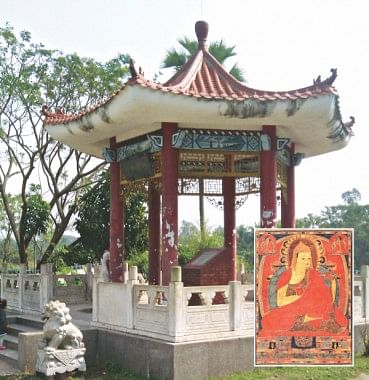Atish Dipankar Srigyan: Light of Asia from Bikrampur, Bangladesh
 Atish Dipankar- Mausoleum at Bajrojogini. Photo Credit: Dipta Saha
Atish Dipankar- Mausoleum at Bajrojogini. Photo Credit: Dipta Saha
Long before Europe's first universities in Bologna (1088); Paris (1150); Oxford (1167); and Cambridge (1209), centres of learning flourished in this part of the world. Established during the Mourya, the Gupta and the Pala dynasties, they attracted scholars from all over the world. Chinese scholar-travelers Fa-Hien (Faxian, 337-422 AD) and Hiuen Tsang (Xuanzang, 602-664 AD) ventured to this part of the world for its archive of knowledge in its libraries. Mahasthangarh (Est: 3rd Cent BC) in Bogra;Mainamati (Est: 8th Cent AD) in Comilla; and Somapura Mahavira (Est 8th Cent AD) in Paharpur, bear testimony of grand civilizations that once blossomed in Bangladesh.
In this heritage, during the Pala era (750-1174 AD), a prince (Chandragarbha) was born in March 980 AD to King Kalyan Sri and Queen Prabhabati. He became one of the most influential scholars and reformers of all time. That prince is none other than OUR Atish Dipankar Srigyan from the village of Bojrojogini in ancient Bikrampur (Munshiganj), Bangladesh.
Prince Chandragarbha was a child prodigy like the Lord Buddha. By ten, he mastered astrology, Sanskrit and the sciences. He also mastered Mahayana- the branch of Buddhism that defined the Pala rulers. The prince soon wished to become a Monk. As legend goes, on the eve of his wedding, the Vajrayana goddess, Tara, visited him. Tara explained to Chandragarbha that in his past life, the prince was a Monk. It took time for Chandragarbha to convince his parents, but in the end, he succeeded. The rest was a fairy tale.
Under the great scholar Jetari, Chandragarbha mastered Buddhism. He also mastered logic and philosophy; grammar; and the sciences. At 19, Chandragarbha was formally ordained a Monk and known as Dipankar Srigyan. It was now time to move to Nalanda in Patna, Bihar- the Oxford, Cambridge and Harvard of its time. After a decade at 29, Acharya Shilarakshita ordained him a full Monk. He would now be known as Atish Dipankar Srigyan (He Whose Deep Awareness Acts as a Lamp). The lamp that first saw light in Bangladesh was now ready to illuminate the world.
In 1012 AD, Atish took to the seas venturing to Subarnadeepa- Java and Sumatra- today's Indonesia, which was then a grand centre of Buddhist learning. He remained there for 12 years learning from Guru Serilingpa Dharmakirti- the greatest Eastern scholar of his time. It was now time to get back to Bengal. On return, Atish ventured to Tamralipi (Sri Lanka).
Back home in 1024 AD, at the request of King Dharmapala, Atish became the Chancellor of Vikramashila, the university in Bhagalpur, Bihar. There were 8,000 students and 108 professors, many of whom came from as far as China, Sri Lanka, Persia and Greece. Alongside Buddhism, the Veda, Upanishadas, literature, logic, medicine, science and astronomy were also studied. Soon Atish became the Chancellor of other universities of the region. The name and fame of Bikrampur's favourite son spread to each and every corner of the Buddhist world. One day a call came from Tibet. Buddhism was in danger. At first, Atish declined. He thought he was too old to venture abroad. The goddess, Tara, came to him in his dream. She put Atish's mind to rest. That was it. At the age of 62, Atish ventured first to Nepal and then reached Tibet in 1042 AD.
Atish conquered the hearts of Tibet with his wisdom and patience. The Tibetans still revere him as 'The Noble Lord' (Jo-Bo Rje). In Bodhi Patha Pradipa (Lamp for the Path to Enlightenment), he summarized and simplified the teachings of Lord Buddha in only 66 verses. These verses had philosophical depth to intrigue Monks as well as the simplicity to baffle even the Shepherds of Tibet. Besides many treatises on Buddhism, Atish wrote on engineering that contributed to boosting agricultural production in Tibet. Atish also translated many Bangla works into the Tibetan language.
Atish failed to return home. Age finally took its toll. At 73, Bikrampur's favourite son left the material world. His mortal Ashes and some personal belongings are still preserved at Nyetang, Tibet. In a twist of history, Atish was forgotten in his birthplace Bengal and South Asia. In the 1890s, Sharat Chandra Das (1849-1917) from Chittagong and later in 1930 Rahul Sankrityayan (1893-1963) traveled to Nyetang. Bengal and South Asia rediscovered Atish. A thousand years after his birth, Chandragarbha returned to his birthplace thanks to the friendly people of China who presented some of his mortal Ashes to Bangladesh in 1978. These Ashes are preserved at Dhammarajika Buddhist Temple at Basabo, Dhaka. The friendly people of China also constructed a Mausoleum at his village, Bojrojogini in Bikrampur (Munshiganj).
Atish Dipankar Srigyan ranks alongside Al-Khwarizmi (780-850); Ferdowsi (940-1020); and Al-Biruni (973-1048) the greatest sages of his time. Through Atish, the teachings of Lord Buddha beaconed to the world. In celebration of Atish's 1033rd Birthday, let us feel proud of our ancient past. 'If you know your history; you will know where you're coming from'. We are no lesser than anybody. Let us feel proud that a 'Light of Asia', Atish Dipankar Srigyan was born in Bikrampur, Bangladesh.
(The author teaches economic theory at Jahangirnagar University. Special thanks Subhashis Bhowmik, Cultural Activist, for key discussions; and Dipta Saha, student of Economics, UIU for photo of Atish Dipankar's Mausoleum).

 For all latest news, follow The Daily Star's Google News channel.
For all latest news, follow The Daily Star's Google News channel. 



Comments